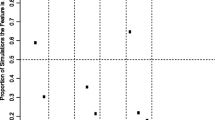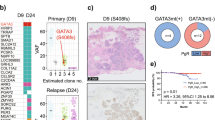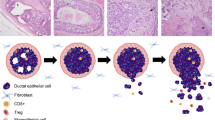Abstract
Purpose
The detection rate of breast ductal carcinoma in situ (DCIS) has increased significantly, raising the concern that DCIS is overdiagnosed and overtreated. Therefore, there is an unmet clinical need to better predict the risk of progression among DCIS patients. Our hypothesis is that by combining molecular signatures with clinicopathologic features, we can elucidate the biology of breast cancer progression, and risk-stratify patients with DCIS.
Methods
Targeted exon sequencing with a custom panel of 223 genes/regions was performed for 125 DCIS cases. Among them, 60 were from cases having concurrent or subsequent invasive breast cancer (IBC) (DCIS + IBC group), and 65 from cases with no IBC development over a median follow-up of 13 years (DCIS-only group). Copy number alterations in chromosome 1q32, 8q24, and 11q13 were analyzed using fluorescence in situ hybridization (FISH). Multivariable logistic regression models were fit to the outcome of DCIS progression to IBC as functions of demographic and clinical features.
Results
We observed recurrent variants of known IBC-related mutations, and the most commonly mutated genes in DCIS were PIK3CA (34.4%) and TP53 (18.4%). There was an inverse association between PIK3CA kinase domain mutations and progression (Odds Ratio [OR] 10.2, p < 0.05). Copy number variations in 1q32 and 8q24 were associated with progression (OR 9.3 and 46, respectively; both p < 0.05).
Conclusions
PIK3CA kinase domain mutations and the absence of copy number gains in DCIS are protective against progression to IBC. These results may guide efforts to distinguish low-risk from high-risk DCIS.


Similar content being viewed by others
References
Meijnen P, Oldenburg HS, Peterse JL et al (2008) Clinical outcome after selective treatment of patients diagnosed with ductal carcinoma in situ of the breast. Ann Surg Oncol 15:235–243
Cutuli B, Cohen-Solal-le Nir C, de Lafontan B et al (2002) Breast-conserving therapy for ductal carcinoma in situ of the breast: the French Cancer Centers’ experience. Int J Radiat Oncol Biol Phys 53:868–879
Wapnir IL, Dignam JJ, Fisher B et al (2011) Long-term outcomes of invasive ipsilateral breast tumor recurrences after lumpectomy in NSABP B-17 and B-24 randomized clinical trials for DCIS. J Natl Cancer Inst 103:478–488
Cuzick J, Sestak I, Pinder SE et al (2011) Effect of tamoxifen and radiotherapy in women with locally excised ductal carcinoma in situ: long-term results from the UK/ANZ DCIS trial. Lancet Oncol 12:21–29
Ernster VL, Barclay J, Kerlikowske K et al (1996) Incidence of and treatment for ductal carcinoma in situ of the breast. JAMA 275:913–918
Fisher ER, Dignam J, Tan-Chiu E et al (1999) Pathologic findings from the National Surgical Adjuvant Breast Project (NSABP) eight-year update of Protocol B-17: intraductal carcinoma. Cancer 86:429–438
Newburger DE, Kashef-Haghighi D, Weng Z et al (2013) Genome evolution during progression to breast cancer. Genome Res 23:1097–1108
Weng Z, Spies N, Zhu SX et al (2015) Cell-lineage heterogeneity and driver mutation recurrence in pre-invasive breast neoplasia. Genome Med 7:28
Johnson CE, Gorringe KL, Thompson ER et al (2012) Identification of copy number alterations associated with the progression of DCIS to invasive ductal carcinoma. Breast Cancer Res Treat 133:889–898
Rane SU, Mirza H, Grigoriadis A et al (2015) Selection and evolution in the genomic landscape of copy number alterations in ductal carcinoma in situ (DCIS) and its progression to invasive carcinoma of ductal/no special type: a meta-analysis. Breast Cancer Res Treat 153:101–121
Kroigard AB, Larsen MJ, Laenkholm AV et al (2015) Clonal expansion and linear genome evolution through breast cancer progression from pre-invasive stages to asynchronous metastasis. Oncotarget 6:5634–5649
Afghahi A, Forgo E, Mitani AA et al (2015) Chromosomal copy number alterations for associations of ductal carcinoma in situ with invasive breast cancer. Breast Cancer Res 17:108
Troxell ML, Brunner AL, Neff T et al (2012) Phosphatidylinositol-3-kinase pathway mutations are common in breast columnar cell lesions. Mod Pathol 25:930–937
Xu R, Perle MA, Inghirami G et al (2002) Amplification of Her-2/neu gene in Her-2/neu-overexpressing and -nonexpressing breast carcinomas and their synchronous benign, premalignant, and metastatic lesions detected by FISH in archival material. Mod Pathol 15:116–124
Weber SC, Seto T, Olson C et al (2012) Oncoshare: lessons learned from building an integrated multi-institutional database for comparative effectiveness research. AMIA Annu Symp Proc 2012:970–978
Kurian AW, Mitani A, Desai M et al (2014) Breast cancer treatment across health care systems: linking electronic medical records and state registry data to enable outcomes research. Cancer 120:103–111
Li H, Durbin R (2009) Fast and accurate short read alignment with Burrows–Wheeler transform. Bioinformatics 25:1754–1760
McKenna A, Hanna M, Banks E et al (2010) The Genome Analysis Toolkit: a MapReduce framework for analyzing next-generation DNA sequencing data. Genome Res 20:1297–1303
Cibulskis K, Lawrence MS, Carter SL et al (2013) Sensitive detection of somatic point mutations in impure and heterogeneous cancer samples. Nat Biotechnol 31:213–219
Lai Z, Markovets A, Ahdesmaki M et al (2016) VarDict: a novel and versatile variant caller for next-generation sequencing in cancer research. Nucleic Acids Res 44:e108
Garrison E, Marth G (2012) Haplotype-based variant detection from short-read sequencing. arXiv:12073907
Wang K, Li M, Hakonarson H (2010) ANNOVAR: functional annotation of genetic variants from high-throughput sequencing data. Nucleic Acids Res 38:e164
Gao Y, Niu Y, Wang X et al (2009) Genetic changes at specific stages of breast cancer progression detected by comparative genomic hybridization. J Mol Med (Berl) 87:145–152
R development Core Team (2015) R: a language and environment for statistical computing. The R Foundation for Statistical Computing, Vienna
Porta-Pardo E, Godzik A (2014) e-Driver: a novel method to identify protein regions driving cancer. Bioinformatics 30:3109–3114
Porta-Pardo E, Garcia-Alonso L, Hrabe T et al (2015) A pan-cancer catalogue of cancer driver protein interaction interfaces. PLoS Comput Biol 11:e1004518
Yang F, Petsalaki E, Rolland T et al (2015) Protein domain-level landscape of cancer-type-specific somatic mutations. PLoS Comput Biol 11:e1004147
Curtis C, Shah SP, Chin SF et al (2012) The genomic and transcriptomic architecture of 2,000 breast tumours reveals novel subgroups. Nature 486:346–352
Cancer Genome Atlas N (2012) Comprehensive molecular portraits of human breast tumours. Nature 490:61–70
Horlings HM, Weigelt B, Anderson EM et al (2013) Genomic profiling of histological special types of breast cancer. Breast Cancer Res Treat 142:257–269
Ciriello G, Gatza ML, Beck AH et al (2015) Comprehensive molecular portraits of invasive lobular breast cancer. Cell 163:506–519
Desmedt C, Zoppoli G, Gundem G et al (2016) Genomic characterization of primary invasive lobular breast cancer. J Clin Oncol 34:1872–1881
Yates LR, Gerstung M, Knappskog S et al (2015) Subclonal diversification of primary breast cancer revealed by multiregion sequencing. Nat Med 21:751–759
Abba MC, Gong T, Lu Y et al (2015) A molecular portrait of high-grade ductal carcinoma in situ. Cancer Res 75:3980–3990
Kim SY, Jung SH, Kim MS et al (2015) Genomic differences between pure ductal carcinoma in situ and synchronous ductal carcinoma in situ with invasive breast cancer. Oncotarget 6:7597–7607
Pang JB, Savas P, Fellowes AP et al (2017) Breast ductal carcinoma in situ carry mutational driver events representative of invasive breast cancer. Mod Pathol 30:952–963
Hernandez L, Wilkerson PM, Lambros MB et al (2012) Genomic and mutational profiling of ductal carcinomas in situ and matched adjacent invasive breast cancers reveals intra-tumour genetic heterogeneity and clonal selection. J Pathol 227:42–52
Liao S, Desouki MM, Gaile DP et al (2012) Differential copy number aberrations in novel candidate genes associated with progression from in situ to invasive ductal carcinoma of the breast. Genes Chromosomes Cancer 51:1067–1078
Hwang ES, Lal A, Chen YY et al (2011) Genomic alterations and phenotype of large compared to small high-grade ductal carcinoma in situ. Hum Pathol 42:1467–1475
Shah V, Nowinski S, Levi D et al (2017) PIK3CA mutations are common in lobular carcinoma in situ, but are not a biomarker of progression. Breast Cancer Res 19:7
Sakr RA, Weigelt B, Chandarlapaty S et al (2014) PI3 K pathway activation in high-grade ductal carcinoma in situ–implications for progression to invasive breast carcinoma. Clin Cancer Res 20:2326–2337
Zhao JJ, Liu Z, Wang L et al (2005) The oncogenic properties of mutant p110alpha and p110beta phosphatidylinositol 3-kinases in human mammary epithelial cells. Proc Natl Acad Sci USA 102:18443–18448
Zardavas D, Phillips WA, Loi S (2014) PIK3CA mutations in breast cancer: reconciling findings from preclinical and clinical data. Breast Cancer Res 16:201
Fry EA, Taneja P, Inoue K (2017) Oncogenic and tumor-suppressive mouse models for breast cancer engaging HER2/neu. Int J Cancer 140:495–503
Ang DC, Warrick AL, Shilling A et al (2014) Frequent phosphatidylinositol-3-kinase mutations in proliferative breast lesions. Mod Pathol 27:740–750
Allred DC, Clark GM, Molina R et al (1992) Overexpression of HER-2/neu and its relationship with other prognostic factors change during the progression of in situ to invasive breast cancer. Hum Pathol 23:974–979
Latta EK, Tjan S, Parkes RK et al (2002) The role of HER2/neu overexpression/amplification in the progression of ductal carcinoma in situ to invasive carcinoma of the breast. Mod Pathol 15:1318–1325
Jang M, Kim E, Choi Y et al (2012) FGFR1 is amplified during the progression of in situ to invasive breast carcinoma. Breast Cancer Res 14:R115
Park K, Han S, Kim HJ et al (2006) HER2 status in pure ductal carcinoma in situ and in the intraductal and invasive components of invasive ductal carcinoma determined by fluorescence in situ hybridization and immunohistochemistry. Histopathology 48:702–707
Borgquist S, Zhou W, Jirstrom K et al (2015) The prognostic role of HER2 expression in ductal breast carcinoma in situ (DCIS); a population-based cohort study. BMC Cancer 15:468
Hoque A, Sneige N, Sahin AA et al (2002) Her-2/neu gene amplification in ductal carcinoma in situ of the breast. Cancer Epidemiol Biomark Prev 11:587–590
Miron A, Varadi M, Carrasco D et al (2010) PIK3CA mutations in in situ and invasive breast carcinomas. Cancer Res 70:5674–5678
Dunlap J, Le C, Shukla A et al (2010) Phosphatidylinositol-3-kinase and AKT1 mutations occur early in breast carcinoma. Breast Cancer Res Treat 120:409–418
Gorringe KL, Hunter SM, Pang JM et al (2015) Copy number analysis of ductal carcinoma in situ with and without recurrence. Mod Pathol 28:1174–1184
Bhat-Nakshatri P, Goswami CP, Badve S et al (2016) Molecular insights of pathways resulting from two common PIK3CA mutations in breast cancer. Cancer Res 76:3989–4001
Dogruluk T, Tsang YH, Espitia M et al (2015) Identification of variant-specific functions of PIK3CA by rapid phenotyping of rare mutations. Cancer Res 75:5341–5354
Acknowledgements
Short-read sequencing assays were performed by the OHSU Massively Parallel Sequencing Shared Resource. We thank Norman Cyr for his artistic contribution to Fig. 2.
Funding
This work is supported by NIH R01CA193694, the Susan and Richard Levy Gift Fund; the Suzanne Pride Bryan Fund for Breast Cancer Research; the Breast Cancer Research Foundation; the Jan Weimer Junior Faculty Chair in Breast Oncology; the BRCA Foundation; and the National Cancer Institute’s Surveillance, Epidemiology and End Results Program under contract HHSN261201000140C awarded to the Cancer Prevention Institute of California. The project was supported by an NIH CTSA award number UL1 RR025744. The collection of cancer incidence data used in this study was supported by the California Department of Health Services as part of the statewide cancer reporting program mandated by California Health and Safety Code Section 103885; the National Cancer Institute’s Surveillance, Epidemiology, and End Results Program under contract HHSN261201000140C awarded to the Cancer Prevention Institute of California, contract HHSN261201000035C awarded to the University of Southern California, and contract HHSN261201000034C awarded to the Public Health Institute; and the Centers for Disease Control and Prevention’s National Program of Cancer Registries, under agreement #1U58 DP000807-01 awarded to the Public Health Institute. The ideas and opinions expressed herein are those of the authors, and endorsements by the University or State of California, the California Department of Health Services, the National Cancer Institute, or the Centers for Disease Control and Prevention or their contractors and subcontractors are neither intentional nor should be inferred.
Author information
Authors and Affiliations
Contributions
RBW conceived and designed the study. CYL conceived and carried out experiments, as well as analyzed the data. S Vennam and HS analyzed the sequencing data (S Venname: single-nucleotide alteration; HS: copy number variations). EL and S Varma carried out the FISH experiments. NJW carried out the targeted exon sequencing. NP, SH, MD, and TS performed biostatistics analysis. MLT conceived the study. AK developed and led the Oncoshare data resource. All authors were involved in writing the paper and gave final approval to the submitted and published versions.
Corresponding author
Ethics declarations
Conflict of interest
The authors declare that they have no conflict of interests.
Ethical approval
All procedures performed in studies involving human participants were in accordance with the ethical standards of the institutional and/or national research committee and with the 1964 Helsinki declaration and its later amendments or comparable ethical standards. As stated in the Materials and Methods section, the study was performed with Health Insurance Portability and Accountability Act (HIPAA)-compliant Stanford University Institutional Review Board (IRB) approval (Protocol number 32496). Because archival tissue was used, a waiver of consent was obtained.
Additional information
Publisher's Note
Springer Nature remains neutral with regard to jurisdictional claims in published maps and institutional affiliations.
Electronic supplementary material
Below is the link to the electronic supplementary material.
Rights and permissions
About this article
Cite this article
Lin, CY., Vennam, S., Purington, N. et al. Genomic landscape of ductal carcinoma in situ and association with progression. Breast Cancer Res Treat 178, 307–316 (2019). https://doi.org/10.1007/s10549-019-05401-x
Received:
Accepted:
Published:
Issue Date:
DOI: https://doi.org/10.1007/s10549-019-05401-x




